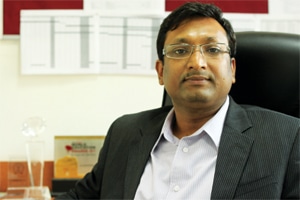
 Gagan Goyal, CEO, ThinkLABS – a quintessential robotics enthusiast who decided to make his passion his profession and bring the world of robotics right into the classrooms of students in conversation with Rachita Jha (ENN). Excerpts
Gagan Goyal, CEO, ThinkLABS – a quintessential robotics enthusiast who decided to make his passion his profession and bring the world of robotics right into the classrooms of students in conversation with Rachita Jha (ENN). Excerpts
Tell us more about the genesis of Robotics Lab?
Robotics is an exciting field of study and fascinates and engages people of all ages-truly a multi-disciplinary subject and brings in more interactivity and fun-based learning in STEM education. It is an ecstatic moment to see young students be it either school or college working in teams and building robots with so much fun and collaboration. It’s amazing to see how robots excite and scintillate their minds. My journey and the genesis of ‘robotics lab’ began during my years as a student at IIT Bombay, and participated in many robotics college competitions and gained a liking and fun in the same. The activity also made be learn the concepts better due to hands-on learning. The subject of robotics is multidisciplinary and one gets a chance to apply the concepts in engineering. So there was disconnect that got bridged by my robots creation. The international level competitions exposed to common presence of robotics in these locations. Robotics emerged as an education tool and a motivational tool and many consider ‘Robotics’ as the fourth R in education after reading, writing and athematic.
Compared to your experience in other countries, how do you see the role of robotics labs in India?
My experience in the US and UK education market revealed that robotics is compulsory and it is very common and important pillar in experiential learning and hands-on learning, especially for science learning. However, in India we were not exposed to robotics for science learning in school education. So I decided to introduce robo labs in India. These labs of making robots not make science learning fun but also give better knowledge in learning skills, life skills, thinking skills, teamwork, and leadership skills. The demand for 21st century skills is coming in face of students that are not based on ability of rote learning instead, the future workplace will require students who can adapt to the situation will excel with problem-solving skills. We all learn better by doing, this has to start from the beginning – to think, create, solve and apply the knowledge that has been gained in the classrooms at school-level itself. The overall benefits of our pedagogy approach helps students gain visual grasp of maths and science concepts and it teaches though the mode of discovery i.e cause-and-effect learning. Students enhance their problem solving skills, innovation and creativity aptitude and strengthen logical and analytical thinking skills.
How have you designed the robotics labs for school students? Tell us more of the various components of the kit?
We have devised a Robotics Learning Systems (RLS), which is a world-class programme specially created for students of class 4 onwards that is designed in a simple way for schools to embrace science and technology through hands-on-learning. The pedagogy applied to the learning system helps train students in six of eight intelligences proposed by the theory of multiple intelligences, thus making it a holistic learning experience. The kit includes hardware building blocks, software licenses, curriculum content and the most important component is teacher training. Our hardware is called i-Pitara PRO which is an ergonomically designed modular, re-programmable kit with more than 100 components like sensors, micro-processor unit, gears, motors, tools etc. Our approach is to ensure that the kit offers innumerable options for creativity, designing and critical thinking. Our software is called CIMPLETM and is based on intuitive visual programming software. The drag and drop, flowchart-based programming approach helps in building the logical thinking of students when they are involved in the robotics labs. To ensure that the labs are in sync with what is taught to them in the classroom, we have designed the courseware in our R&D centre at SINE, IIT Mumbai that helps the concepts that are taught in the robotics labs integrate easily with the existing school curriculum. The heart of the kit remains with the teacher training component, as unless the teacher is involved, motivated and aware of the learning concepts embedded in the robotics labs, the students will never reap the true benefits of the same.
| “Currently we assess that the robotic lab market in Indian education sector is close to 1000 crore, and the space for robotics labs is an unexplored market. So the potential can actually be much more.” |
Tell us more on the robotics labs designed for higher education students?
The needs of higher education engineering students are very different and are more career-focused, so we have designed a course in embedded systems to make them robotic engineers. Distinguished faculty and alumni of IIT Mumbai have designed the courseware aimed at universities, colleges, institutes covering various skill sets required for a successful career in Embedded systems. We invest in setting up of a centre of excellence for Embedded System with state-of-art laboratory carrying out education and research activities. Monitoring the skill gap in a structured manner, followed by placement and internship opportunities for certified students are offered. The intensive hand-on learning projects have helped many students realize their dreams in embedded systems.
Usually due to constraints of time and space, many schools are unable to pursue lab activity in their timetable. What is your suggestion to schools on adoption of robo labs on this?
We are fully aware of these constraints that are common to all schools across the country, the mission to complete the syllabus usually does not give any space for such workshops and labs. So, we suggest the best way out for schools is to upgrade their existing computer labs to robotics labs. Robotics should be included as a subject and the real-life impact will come if it becomes part of the curriculum. We suggest at least two periods in a month. The time has come for computer labs to transform as a centre for holistic learningof other subjects as most of the computers and related applications are on self-learning by the students. So we will see the arrival of language labs, math labs and of course robotics labs as learning modules.
Having entered a market untapped by any, tell us your views on how the education market evolved for robotics labs in India? What is your market assessment for robotic labs in India?
We are a five-year old company and we started with engineering students and for us school education in a new avenue for us. And there is lots of effort that went behind our launch of our products for the school segment as we had to design our platform that was very elementary and student-friendly-so those took a lot of time from us. Schools are not alien to the various modes of experiential and activity-based learning for students, and this is evident from our involvement in just 38 schools last year to 108 schools this year. Acceptance from the education community has been very forthcoming, and we are seeing the demand coming from Nasik and other tier-3 cities much more.Currently we assess that the robotic lab market in Indian education sector is close to 1000 crore market, and the space for robotics labs is an unexplored market so the potential can actually be much more.





















